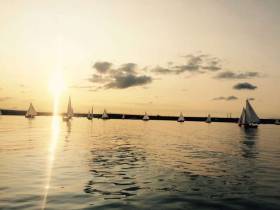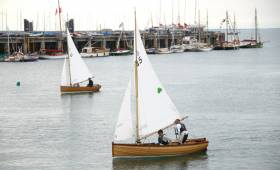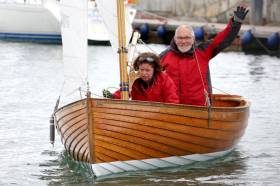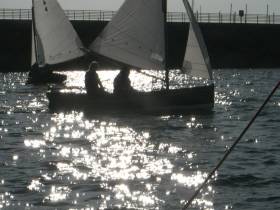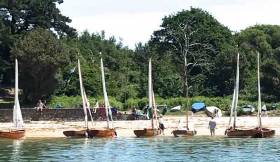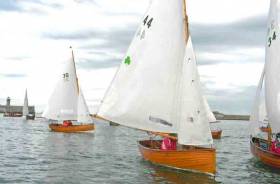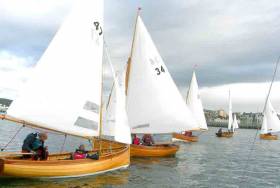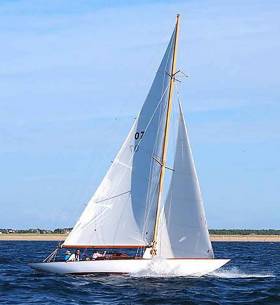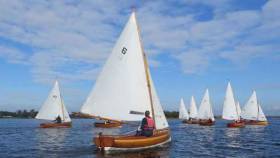Displaying items by tag: Water Wag
Water Wags Set Sail in Heritage Week Race at Dun Laoghaire
Heritage week runs from 19th to 27th August, and the Water Wags are part of Ireland’s heritage, and thus the race for 23rd. August was a Heritage Week event.
The wind blew force four at the beginning, so, some of the competitors were asking if we would be better reefed? The clouds above ensured that the wind would be shifty in direction.
The committee, under the leadership of Tom Hudson laid a suitably long line for the 25–boats competing. By the start of the race the wind had dropped to a kindly 10–knots which is perfect weather for Water Wags.
The fleet were quite evenly spread along the line, and those nearest to the committee boat end tacked off early to obtain benefit from the rising tide. At that stage, nobody realised what a game of snakes and ladders it would become. Over the first beat, the wind dropped down to about four knots along the marina side, while near the harbour mouth, there was no wind. Mariposa was first at the windward mark. On the first run it did not matter a bit which side one took, or which gybe. There were few gains to be made. More significant was the leeward marks.
Those who took the starboard mark remained in wind, while those who took the other mark were left out to dry. At the next windward mark the brave committee decided not to shorten the race, and to set the Water Wags on a second lap. At that stage the order was Mariposa, Little Tern, and Pansy. Again, the run offered few opportunities other than the straight line. On the third beat, the wind was offered, and as quickly taken away from the competitors. At the final windward mark the race was shortened with the order:
1st – 45, Mariposa- Cathy MacAleavey & Con Murphy.
2nd.- 36 Little Tern- Tim & Marcus Pearson.
3rd. - 3, Pansy, - Vincent Delany and Emma Webb.
4th. - 38, Swift,
5th. -24, Gavotte.
6th. -41, Mollie,
7th. – 12, Alfa.
8th. - 16, Penelope.
9th. -9 Marie Louise.
10th. -20 Badger.
11th. -42, Tortoise.
12th. -4, Vela.
13th. -18, Good Hope
14th.- 40, Swallow.
15th. -43, Freddie.
16th. – 33, Eva.
17th. -44, Scallywag.
18th. -31, Polly
19th -34, Chloe.
20th. -17, Coquette.
21st. – 30, Sara.
22nd. -15, Moosmie.
23rd.. -26, Nandor,
24th. -08, Eros.
25th. -47, Peggy.
Classic Boat Variety at Glandore Regatta
If variety is the spice of life, then the 25th Anniversary Glandore Classics Regatta is currently staging the most vibrant and flavoursome boat show on the Irish coast writes W M Nixon.
Admittedly the mid-week routine, which will lead on to events like races to Castlehaven (or Castletownshend if you prefer), doesn’t have quite the same hectic pace as the opening weekend. But for connoisseurs of classic or traditional or even just plain odd boats, it’s a feast for eye, memory and analysis which has seen some vividly contrasting boats all united in at least one purpose.
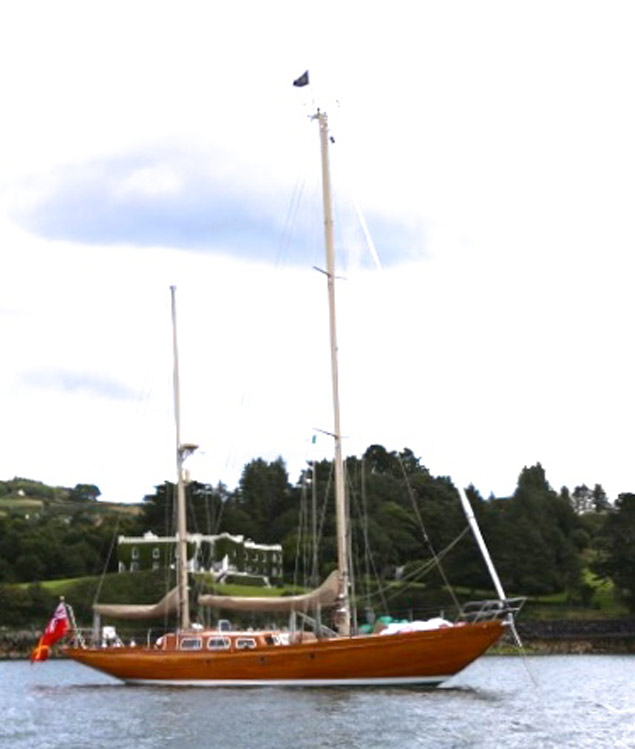 Flagship for style. The 1970 McGruer ketch Cuilaun at Glandore exemplifies the contemporary standard for classic yacht maintenance and presentation. Photo: Gary MacMahon
Flagship for style. The 1970 McGruer ketch Cuilaun at Glandore exemplifies the contemporary standard for classic yacht maintenance and presentation. Photo: Gary MacMahon
That purpose was to honour the memory and achievement of the late Theo Rye (1968-2016). He was taken from us all too soon last Autumn. But in his short life, his passion for yacht and boat design - its history and its future – was an inspiration for all who came in contact with him, and particularly those with whom he worked on a variety of projects which could range from the smallest of boats right up to the ultimate Fife restoration, the giant 23 Metre Cambria
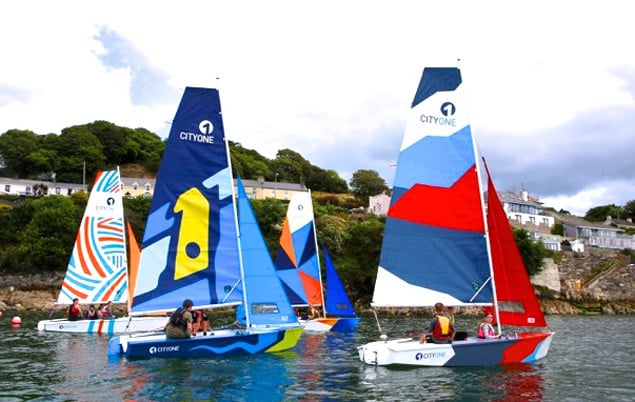 The CityOnes from Limerick cutting a dash with a difference at Glandore. It takes an effort to realize they were designed by Theo Rye, yet he could comfortably take such unusual challenges in his stride. Photo: Gary MacMahon
The CityOnes from Limerick cutting a dash with a difference at Glandore. It takes an effort to realize they were designed by Theo Rye, yet he could comfortably take such unusual challenges in his stride. Photo: Gary MacMahon
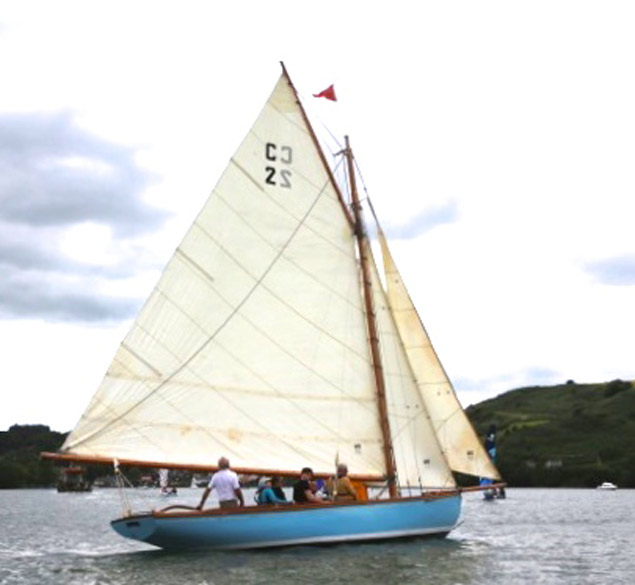 The Cork Harbour One Design Elsie (Patrick Dorgan) at Glandore. She was desined by William Fife in 1895-96. Photo: Gary MacMahon
The Cork Harbour One Design Elsie (Patrick Dorgan) at Glandore. She was desined by William Fife in 1895-96. Photo: Gary MacMahon
In Glandore, there are currently several boats which have benefitted from Theo’s expertise, or could do were it so wished. For instance, a regular at Glandore is the modernized Clyde 30 Brynoth, a Fife creation of 1905. If anyone had ever planned to bring Brynoth back to her original form, it would have been so reassuring to entrust the project to Theo’s encyclopaedic knowledge of the Fife design and build canon.
Yet the breadth of his influence and expertise is also seen in Hal Sisk’s eye-catching yet under-stated 63ft powercruiser Molly Ban, which is in Glandore to act as mothership to the owner’s Dublin Bay Water Wag. Molly Ban could be claimed to find inspiration from may sources, but she is such a unique combination of seagoing powerboat and classic dinghy mothership that we could reasonably argue she is sui generis, she’s just her own sweet self, and that’s all there is to it.
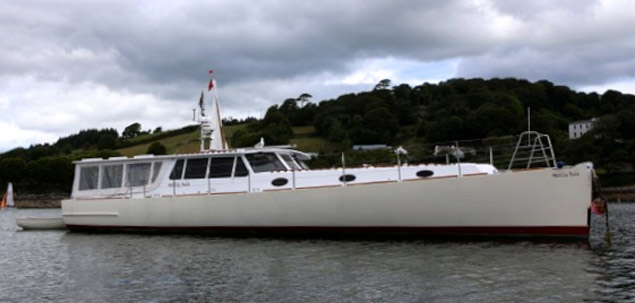 The 63ft Molly Ban is an elegant multi-purpose vessel whose large self-draining cockpit can be used as a “deck garage” for smaller classic craft. Photo: Gary MacMahon
The 63ft Molly Ban is an elegant multi-purpose vessel whose large self-draining cockpit can be used as a “deck garage” for smaller classic craft. Photo: Gary MacMahon
In addition to the owner’s advanced technical experience, Molly Ban saw the combined talent of Nigel Irens and Theo Rye put to work to create a very elegant and distinctive vessel so easily driven that, with a single 300hp Cummins diesel, she has a maximum loaded speed of 16 knots and makes an easily-reached 14 knots on 30 litres of fuel an hour. Yet if you throttle back to 10 knots – a tidy enough speed for most cruising – she burns only ten litres an hour.
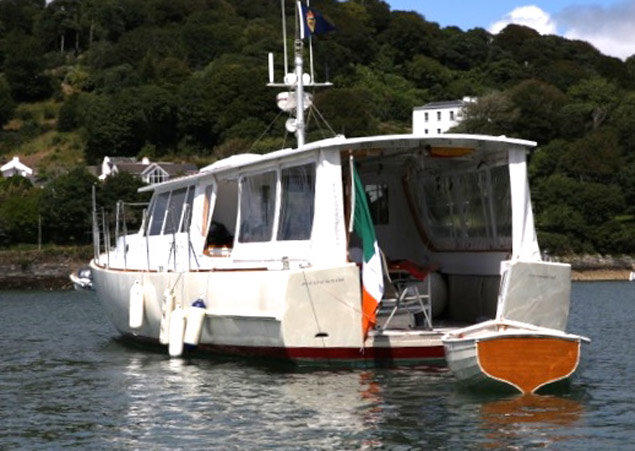 The stern view of Molly Ban gives a hint of the ingenuity of her design. The little clinker tender is based on a dinghy built for Hals Sisk’s grandfather in 1926. Photo: Gary MacMahon
The stern view of Molly Ban gives a hint of the ingenuity of her design. The little clinker tender is based on a dinghy built for Hals Sisk’s grandfather in 1926. Photo: Gary MacMahon
There’s a completeness to the Molly Ban concept which is a credit to the memory of Theo Rye. But equally, in looking at the presentation of all the top classics at Glandore, you realize that you’re looking at yachts which have been raised to a standard which Theo and others like him ensured was set, and then adhered to, and if anything improved over time.
His mind could also produce totally off-the-wall solutions to design challenges. But though we all know that it was Theo Rye who came up with the completely innovative design for the CityOne dinghies to be built by the Ilen Boatbuilding School in Limerick, nevertheless at Glandore it was still pause for thought to see them sharing the sea with the utterly classic Dublin Bay Water Wags, a design of 1900 which Theo Rye equally cherished.
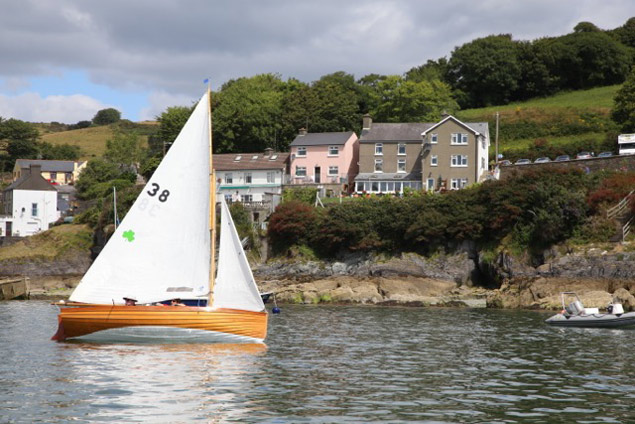 The timeless elegance of classic clinker construction. Guy Kilroy heels his modern-build Water Wag Swift to make the best of zephyrs at Glandore. Photo: Gary MacMahon
The timeless elegance of classic clinker construction. Guy Kilroy heels his modern-build Water Wag Swift to make the best of zephyrs at Glandore. Photo: Gary MacMahon
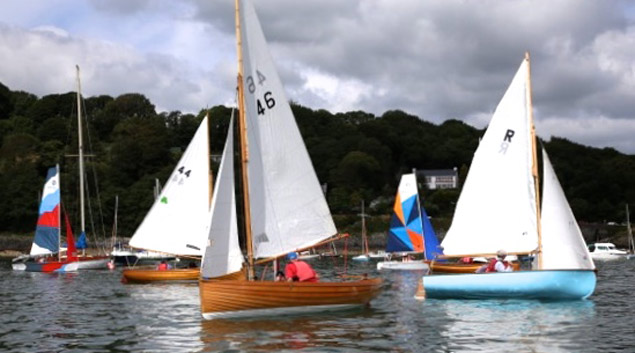 Mixing the fleets – Water Wags from Dublin Bay, CityOnes from Limerick, and a Rankin from Cork Harbour share the waters of Glandore. Photo: Gary MacMahon
Mixing the fleets – Water Wags from Dublin Bay, CityOnes from Limerick, and a Rankin from Cork Harbour share the waters of Glandore. Photo: Gary MacMahon
With four CityOne dinghies available in Glandore for an inter-area Theo Rye Memorial Series, Race Officer Donal Lynch was able to provide competition for a representative selection with crews from Limerick, the County Clare folk of Seol Sionna who had arrived in Glandore with their own distinctive Shannon Estuary hooker Sally O’Keeffe after a fine overnight passage from Kilrush, a West Cork crew with some involved in the restoration of the ketch Ilen at Oldcourt, and a Cork city team.
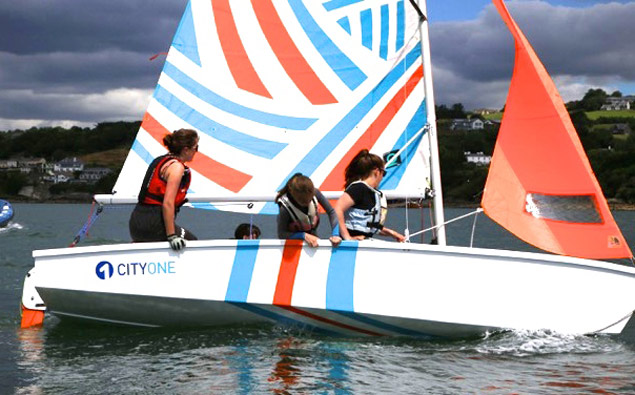 The Cork crew in the Inter-Area series for CityOnes were Nicola Cowhig (helm), Aoife & Muireann O’Donnell, and Gemma. Photo: Gary MacMahon
The Cork crew in the Inter-Area series for CityOnes were Nicola Cowhig (helm), Aoife & Muireann O’Donnell, and Gemma. Photo: Gary MacMahon
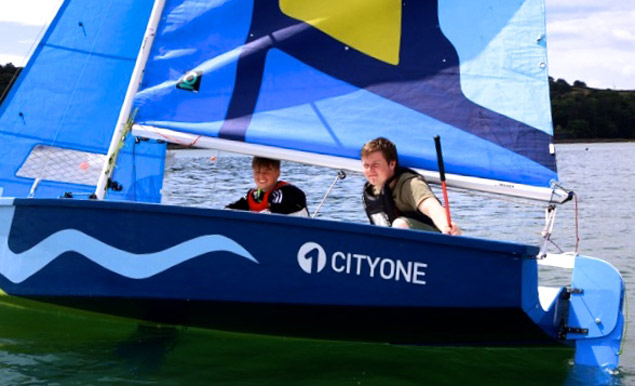 They may not look like they’re going anywere fast, but Limerick’s Donal Coffey (helm, right) and Sean McNulty won the Theo Rye Memorial Series for the CityOne dinghies. Photo: Gary MacMahon
They may not look like they’re going anywere fast, but Limerick’s Donal Coffey (helm, right) and Sean McNulty won the Theo Rye Memorial Series for the CityOne dinghies. Photo: Gary MacMahon
In the end, it was the Limerick duo of Donal Coffey (helm) crewed by Sean McNulty who won the weekend series overall, but really it was the way that the CityOne dinghies so ably fulfilled the role envisaged for them by Gary MacMahon of the Ilen School and Theo Rye which was the abiding memory.
As the photos reveal, Donal Lunch has had quite a challenge in setting races for all classes which will be manageable despite a shortage of wind, with further frustration early in the week as the underlying northerly airstream tended to negate the efforts of the warming summer days to create a sea breeze, but by week’s end we hope to get reports of improved sailing.
Meanwhile, a view of the classic style currently gracing the Glandore anchorage is more than enough to be going along with.
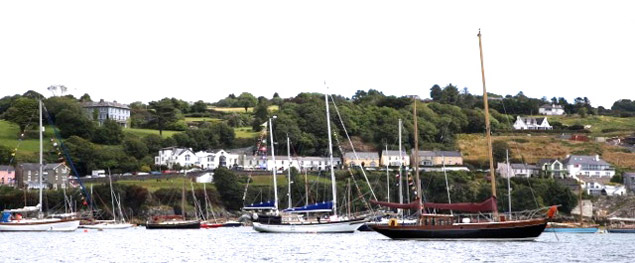 “Eclectic” would be the best word for the fleet at Glandore. Photo: Gary MacMahon
“Eclectic” would be the best word for the fleet at Glandore. Photo: Gary MacMahon
Cotton Topsails Hoisted as National Yacht Club Welcomes Classic Boat Fleet for Kingstown 200 Cup
It could be over 50 years since a cotton topsail has been seen from the National Yacht Club and this afternoon as the classic fleet arrived "Peggy Bawn", a GL Watson 36–ft Cutter, built in 1894, hoisted her cotton suit of topsail and gaff main.
A temporary pontoon as been anchored off the Carlisle Pier and here the renovated Dublin Bay 24 footer "Periwinkle" this afternoon having sailed from France via the Scilly's and Greystones where some former 24 hands with long association with the class shipped on board, Chris Johnson, David Espey, Chris Craig and Terry Johnson.
On the National Yacht Club platform the Dublin Bay Mermaids were arriving by road and a fleet of "Fifes" from Royal Anglesey Yacht Club were being masted and launched having arrived by ferry.
The fleets arrival for the opening of the Volvo Dun Laoghaire Regatta and the inclusion of the classics for this edition will provide a historic spectacle from the East Pier.
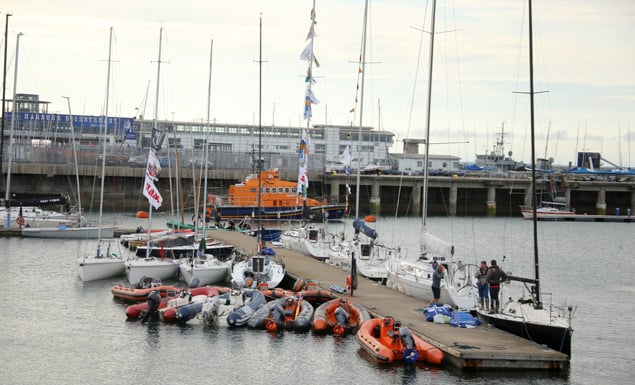 Dun Laoghaire Regatta entries line up at the National yacht club pontoon ahead of tomorrow's regatta
Dun Laoghaire Regatta entries line up at the National yacht club pontoon ahead of tomorrow's regatta
Chloe Wins Buckingham Cup As Dun Laoghaire Water Wags Are 'Discommoded By Cruise Liner'
For the second handicap race of the year, for The Buckingham Cup and The Wigham Trophy, the Dun Laoghaire Water Wags were discommoded by a 9,975 ton, 440ft long cruise liner, The Star Pride with her 208 passengers and 164 crew.
She was scheduled to leave the Carlisle Pier at 18.00hrs but there was an upset to her plans. Allegedly, a replacement part was required for her engines, which was being delivered from Dublin Port by car, leaving the latter venue at 18.00hrs. Instructions were conveyed to the Water Wags by Harbour Company officials. The reality was something different. At approx. 18.45hrs the tugboat Burfort arrived in Dun Laoghaire harbour joined by the Dublin Port harbour pilot. They set to work quickly, towed The Star Pride by the stern, until the liner was in the centre of the harbour. They then spun her, until the bow was pointing towards the harbour mouth.
The Wags quickly launched, the committee boat then laid a four-lap course with a start line near the marina entrance, and windward mark under the East Pier Lighthouse. The first Water wag to start was Nandor, followed half a minute later by Chloe, and Coquette, Polly and Scallywag two minutes later. Last to start after the passage of six minutes were Moosmie, Gavotte, Swift, Tortoise and Eva.
As the race developed the early starters merged with some of those faster boats attacking from behind. It soon became clear that the leaders, mother and daughter team of Kate & Amy O’Leary in Chloe and Mc Bride & McBean in Nandor were in for a great battle. A similar battle developed between Hal Sisk and Sue Westrup in Good Hope and Ian Magowan in the recently restored Mary Kate. At the finish, the order was:
1st – 34, Chloe. Kate & Amy O’Leary
2nd. -26, Nandor, Brian McBride and Stuart McBean
3rd.- 6, Mary Kate, Ian & Jenny Magowan
4th. -18, Good Hope
5th. -46, Mademoiselle
6th. - 3, Pansy
7th. -Moosmie
8th. - 38, Swift
9th. - 10, Sprite
10th. -30 Sara
11th. -45, Mariposa
12th. -42, Tortoise
13th. -17, Coquette
The Collen Cup is a new perpetual trophy which has been in the Collen family since 1907 and will be awarded to the overall winner of the Water Wag Class within the Classic section of this and subsequent Volvo Dun Laoghaire Regattas.
The Trophy will be presented by Pamela Collen, on this, the 207th year of the Collen families’ Construction business and on the occasion of the 200th anniversary of the Dun Laoghaire construction commencement.
The Collen Family has had a long association with The Royal Irish Yacht Club. Lyal Collen who married Euphemia Adelaide Falkiner (a daughter of past Commodore Dr. Ninian Falkiner) was an active member throughout his life. The Collen Cup is in honour of Euphemia Adelaide Falkiner, mother of Neil Collen, current Chairman of the firm, who sailed in the Water Wag fleet on Shindilla in the 1950s and 1960s.
Sharing a bicentenary with Dun Laoghaire Harbour, Collen is a main sponsor of the 2017 Volvo Dun Laoghaire Regatta.
It’s probably more than a little sacrilegious to suggest that, as some of the rituals of a global religion are built around The Last Supper, then it’s not at all unreasonable for the world’s oldest One-Design sailing class to have its rituals built around The First Picnic writes W M Nixon.
But the thought springs irresistibly to mind on seeing the first image of the Dublin Bay Water Wags settling into their new home for the week, southern Brittany’s incomparable inland sea of the Morbihan, currently en fete with a fleet of 1400 craft of all sizes for the biennial Festival of Sail which has been getting under way today.
The Dublin Bay Water Wags make up just 1% of the fleet, with fourteen boats present. But that’s not bad going for a class founded in 1887. Admittedly the boats now in France are of a type introduced to the class in 1900, yet that still makes them older than most other boats present, though not the two Howth 17s Leila and Aura of 1898 vintage, there in France with four other newer boats of their class
It was when the two Irish classes finally met up today that the Water Wags were found having a picnic. Not a very organized one admittedly, and definitely not Glyndeburne style, as it was little more than a lunch stop at a handy beach.
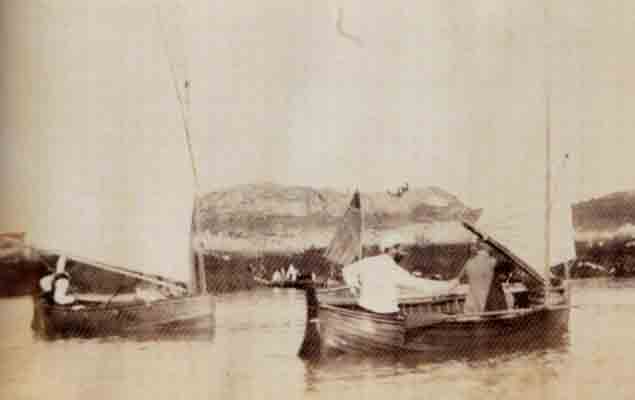
The First Picnic. Midsummer’s Day 1887, and the Water Wags (of the original 13ft type) are gathering at Dalkey Island. Photo courtesy Water Wags
Nevertheless it sparked thoughts of The First Picnic, which was held on Dalkey Island on Midsummer’s Day, June 21st 1887, when the Water Wags were in their first year, and were sailing the little double-ended 13ft dinghies that were the basis of the class for their first dozen years.
It was combined with a “cruise” from what was then Kingstown Harbour to celebrate Queen Victoria’s Golden Jubilee. And as the photos from Alfred & Vincent Delany’s excellent history of the Water Wag class reveal, Victorian picnics were not something to be undertaken lightly. This is Serious Fun in a tradition which the class have continued ever since. So they’ll probably be very offended by any thought that this photo just in from the Morbihan suggests for even a nano-second that they’re having a picnic.
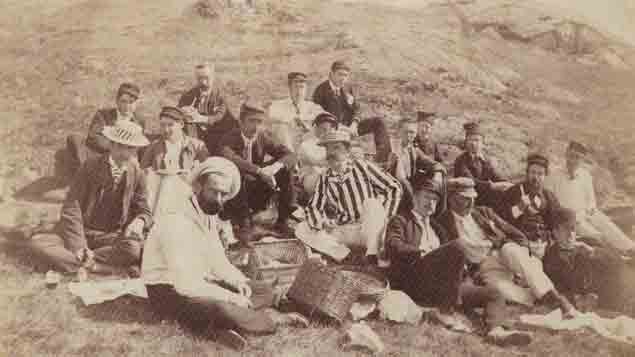 These are Serious Picnic People – the Water Wag Class members and guests on Dalkey island, June 21st 1887. Photo courtesy Water Wags
These are Serious Picnic People – the Water Wag Class members and guests on Dalkey island, June 21st 1887. Photo courtesy Water Wags
Les Wags de L’eau a la Semaine de Golfe de Morbihan
Over the next few days fourteen Water Wags will head by ferry to France to participate in one of the greatest classic boat regattas in Europe. As Afloat.ie reported previously, one thousand four hundred and forty two traditional workboats and recreational boats will head to Brittany from Britain, Ireland, Netherlands, Belgium, Switzerland, Austria, Czech Republic, Spain, and Japan.
Among the 19 yachts of the Irish contingent travelling to the celebration of traditional yachting are:
Waterwags: 9, Marie Louise (1927), 17, Coquette (1909), 31, Polly (1984), 32, Skee (1985), 33, Eva (1986), 34, Chloe (1991), 38, Swift (2001), 40, Swallow (2003), 41, Molllie (2005), 44, Scallywag (2009), 45, Mariposa (2015).
Howth 17 ft: Aura (1898), Deilginis (1905), Eileen (1908), Gladys (1907), Leila (1898), Silvermoon (1898).
Others: Anna Panna, a Mcmillan gaff cutter. Sylvana, Moody 46 and possibly the only boat which will sail to the event instead of being trailed.
What a celebration of Irish craftmanship it will be.
Yesterday evening the Water Wags raced for the Buckingham Cup & Wigham Trophy with handicaps applied at the start, resulting in some boats starting five and a half minutes ahead of others. The handicaps were allocated on the basis of average finishing places in the three championship races held to date. At the time when the first boats started, there was almost no wind in that part of the harbour, and the course was laid for the expected wind from the east, and there was much congestion and dirty wind in the starting line area. The start guns sounded at approximately one minute intervals, but due to lack of wind many boats failed to start on their allocated times.
At the first mark, Paul & Anne Smith in Sara led from Ben McCormack in Marcia and Nandor with Brian Mc Bride and Stuart McBean sailing in 5 knots of wind. These three managed to escape the wallowing at the start area, and built up a huge lead. On the downwind legs, there was much effective blanketing in the following fleet caused by spinnakers of the following boats.
On the final beat, a large black cloud was building up over Dublin City. Eventually, the wind caused by this cloud revealed itself as a strong southerly wind of about 12 knots which hit some of the fleet with such a surprise, that a few boats nearly capsized.
At the finish the order was:
1st – 30, Sara, Paul & Anne Smith.
2nd - 45, Mariposa.
Cathy MacAleavey & Con Murphy
3rd.-33, Eva,
Orla Fitzgerald & Katie Tingle.
4th. 38, Swift, Guy & Jackie Kilroy
5th. - 44, Scallywag. Dan O’Connor & David Williams
6th. -15, Moosmie, David MacFarland.
7th. - Skee, Jonathan & Carol O’Rourke.
8th. - 31, Polly. Richard Mossop and Henry Rooke.
9th. – 46, Mademoiselle.
10th. –37, Marcia.
11th- 36, Little Tern.
12th. – 41, Mollie.
13th. -42, Tortoise,
14th. – 16, Penelope.
15th. - 18, Good Hope.
16th. -3, Pansy,
17th. – 4, Vela.
18th. – 40, Swallow.
19th. -43, Freddie.
20th. -47, Peggy.
21st. -20, Badger.
22nd. –26, Nandor.
23rd. -17, Coquette,
24th. -10, Sprite,
25th. - 34, Chloe,.
26th. -6, Mary Kate
Classic Dublin Bay 24 Yacht to Return to Dun Laoghaire
The last time the Alfred Mylne-designed Dublin Bay 24s raced together in their home waters was Saturday, September 25th 2004 writes W M Nixon. Since then, the class has been through various traumas as projects for a group rebuild/restoration in France fell victim to the financial crisis.
However, the boats were kept in store, and two years ago a complete re-build programme for one of them, Periwinkle, was put into action at Skol ar Mor, the pioneering boat-building school in South Brittany run by Mike Newmeyer.
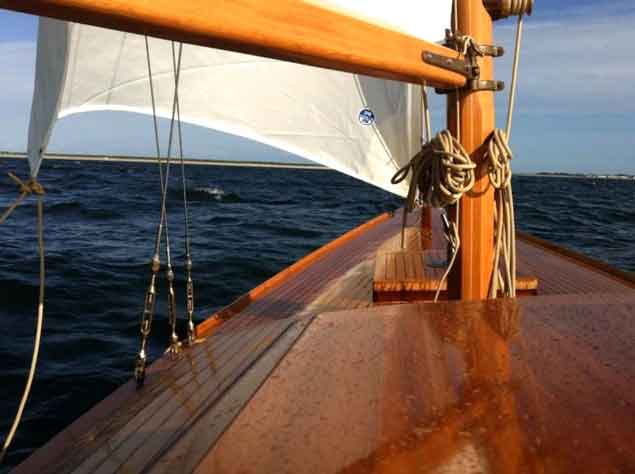 Sailing aboard the restored Periwinkle. The quality of the bronze fittings on the mast matches the high standard of the restoration. Photo Brian Mathews
Sailing aboard the restored Periwinkle. The quality of the bronze fittings on the mast matches the high standard of the restoration. Photo Brian Mathews
Perwiwinkle has turned all heads any time she goes sailing, but there’s no doubt she’d make most impression in an active class setting. As it is, for this year’s Morbihan Festival of Classic and Traditional Boats in the last full week of May, she’ll be sharing the waters of that noted inland sea with boats from home, as twelve Dublin Bay Water Wags and eight Howth Seventeens are being trailed, ferried, and trailed again to take part in one of the greatest gathering of character boats in the world.
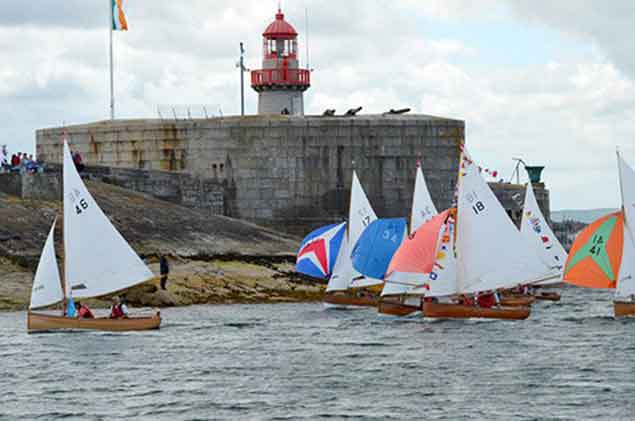 Water Wags in festive mode for their 125th Anniversary in 2012 at Dun Laoghaire Harbour mouth. In ten days time, 12 of them will be in France en route to the Morbihan Festival
Water Wags in festive mode for their 125th Anniversary in 2012 at Dun Laoghaire Harbour mouth. In ten days time, 12 of them will be in France en route to the Morbihan Festival
But while the Water Wags and the Howth Seventeen will be sailing in the enormous fleet, Periwinkle will be on static display afloat, alongside the Skol ar Mor booth at the boat show in the port of Vannes at the head of the Morbihan, though there is a possibility that renowned designer Francois Vivier will take her out for a sail. Happily, though, she’ll soon definitely be sailing – and she’ll be sailing to Dublin Bay.
Owners Chris Craig and David Espey are determined to get her back in time for the Classics Division in the Volvo Dun Laoghaire Regatta from 6th to 9th July, and will be sailing her up from Brittany with a target time of 1st July pencilled-in for arrival in Greystones. Their hope is that former DB24 sailors will then join them to sail on to Dun Laoghaire on Sunday July 2nd.
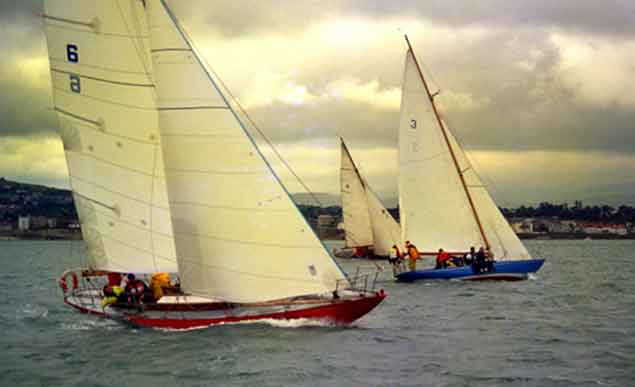 Class racing act. The Dublin Bay 24s in action at the Dun Laoghaire Woodenboat Regatta 1997. Photo: W M Nixon
Class racing act. The Dublin Bay 24s in action at the Dun Laoghaire Woodenboat Regatta 1997. Photo: W M Nixon
As for the rest of the DB24 fleet, their elegant yet tired hulls are finding new purpose in boat-building schools. In September, Adastra will go to Albaola Scholl in San Sebastian in northern Spain, Zephyra is being shipped across the Atlantic for the Apprentice Shop in Maine, and Arandora is to be completed in Les Atelier de L’Enfer in Douarnenez in Brittany. Mike Newmeyer is working on a plan for Euphanzel, and various proposals are being discussed regarding the future of Harmony and Fenestra.
It has been – and still is - a long and difficult journey. But the arrival of Periwinkle in Dublin Bay will surely be a very significant step
22–Boat Water Wag Turnout Includes A Capsize in Wednesday's Lively Race at Dun Laoghaire
It wasn't only last night's Dublin Bay keelboats that were having a lively start to 2017 after the spell of north–easterlies. The DBSC Water Wags also had a pretty lively sail on Wednesday with 22 Wags out in force.
Tim Pearson’s Little Tern capsized and was the only non finisher, it was the second race of a mini series within the overall racing series.
After two races Moosmie - David McFarlane and Ciara Bourke are leading the pack with 2 wins for the Newsom Memorial Cup, Eva with Katie Tingle and Dermot O’Flynn leading Divsion 1B for the Hilposteiner Tankard. Chloe with Kate O’Leary and Hugh Delap are leading Division 2 for the Phyllis Cup.


























